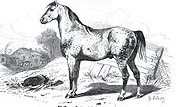Norfolk Trotters, also known as Norfolk Roasdsters, are an
extinct horse breed once native to East Anglia and Norfolk, England. They were
claimed to be ‘a large-sized trotting harness horse originating in and around
Norfolk’.
In 1542, King Henry the eighth required the rich citizens to
keep a specific number of trotting-horse stallions. Norfolk Trotters were well
praised in Norfolk, and later became known as the Norfolk Trotter.
Norfolk Trotters became the standard travel horse in
England. In the city of Yorkshire, the same breed was known as the Yorkshire
Trotter. Norfolk trotters were also known as roadsters. It is common to see the
term Norfolk / Yorkshire Roadster / Trotter in breed-history books; regardless
of the name, all are the same breed of horse. They were used under saddle as
one of the fastest means of travel in areas where there were no established
roads. They were known for their ability to carry a heavy man for great
distances at speeds up to 16-17 mph. Trotting races were very popular in the
early part of the nineteenth century and Norfolk Trotters performed very well
in them.
A Norfolk Trotter stallion, Bellfounder, was imported to the
United States in 1822, and he proved to be a major influence in the founding of
the Standard breed by becoming the damsire of Hambletonian 10. Norfolk Trotters
are also strongly influenced today's modern Hackney horse.
